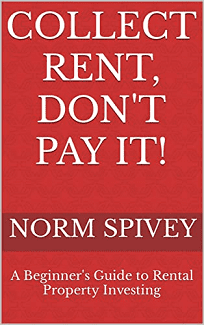What is Cap Rate and Why Does it Matter?
By Norm Spivey, Author of Collect Rent, Don’t Pay It!: A Beginner’s Guide to Rental Property Investing
Ask ten investors “What is Cap Rate?”, and you’re likely to get ten different answers! I’ll provide the definition I use, as it relates to rental properties. Capitalization or Cap rate as it is often called is simply the net income (rent after subtracting all expenses) divided by the value of the asset and expressed as a percentage.
For instance, if annual net rental income for a property is $10000 and the property is valued at $100000 then the cap rate is 10%. This is the “math” often used when a buyer is looking at a property to determine if the investment is a good fit. Determining cap rate, no matter how you calculate it, is a crucial step before making an offer on a property!

Let’s say you are relaxing at home and surfing your favorite online real estate site looking for the next great multi-family investment opportunity. There is an attractive duplex for sale and the seller is asking $400,000. Take 10% of the ask ($40,000) and divide by 12. This equals $3,333 per month estimated gross for the property or almost $1,700 per unit.
If you’ve completed an initial market research for the area and know that there is no possible way that class of property at that location will bring over $1,200 per unit given the current rental market conditions, then the sellers ask is too high. May be best to keep on scrolling or be prepared to do some negotiating!
Using the reverse of the 10% rule, one can figure out a good price range to start a search. If $1,200 per month per unit is the average rent for a good duplex in the area, then take $2,400 and multiply by 12. This equals $28,800. Multiply by 10 and you get $288,000. This would be a good starting point for a search. I can’t stress enough the “10% rule” is just an initial screening tool to get an investor in the ballpark. There is no real science behind it. A detailed capitalization rate analysis must be performed before even thinking about making an offer!
There are numerous ways to more formally calculate cap rate and I recommend figuring it conservatively by using maximum projected expenses and minimum expected rents. I am by no means an Excel expert, but using a spreadsheet with very simple formulas is how I tackle the math. First, one has to determine the anticipated rents per unit. I generally will figure this for several price points and always go conservative using numbers a little below actual market rents.
Next expenses. I will generally include a 10% vacancy rate, however, after 14 years in the rental property business, I’ve never had close to a 10% vacancy rate! Again, my practice is to plan conservatively so I get a good idea of the potential risks. Other expenses will include property taxes, insurance, any utilities that may be included, Homeowners Association (HOA) fees as applicable as and maintenance costs.
Perhaps the most important category of expense is “repairs” which is different than maintenance. Upon inspection, you may determine a property will need HVAC, a roof, and new windows within the next 10 years. When figuring cap rate, you can usually spread these repair costs out over a few years.
Once all expenses are estimated, subtract the total from the gross annual income which gives the Net Operating Income (NOI). Now take the NOI and divide it by the price of the property. The result is the cap rate. Similar to using different price points for rents, I’ll also calculate cap rate for a range of purchase prices equaling 7%-10% capitalization rate. Obviously the higher the cap rate the better when considering a property.
Note I didn’t mention including mortgage principal and interest as part of the net operating expenses. Some investors do but many don’t when determining cap rate. I usually do as mortgage payments are certainly expenses. To that point and as previously stated, there are a million ways to determine cap rate. I’ve shared my method but be sure to find the one that works best for you.
Determining cap rate goes hand in hand with location, location, location. Once an investor has found the right location, viewed some properties, and then completed the math, then it’s time to make an offer and let the negotiating begin. Math doesn’t lie and I can’t imagine considering investing in a rental property without completing this important first step!
About the Author

















 Accessibility
Accessibility